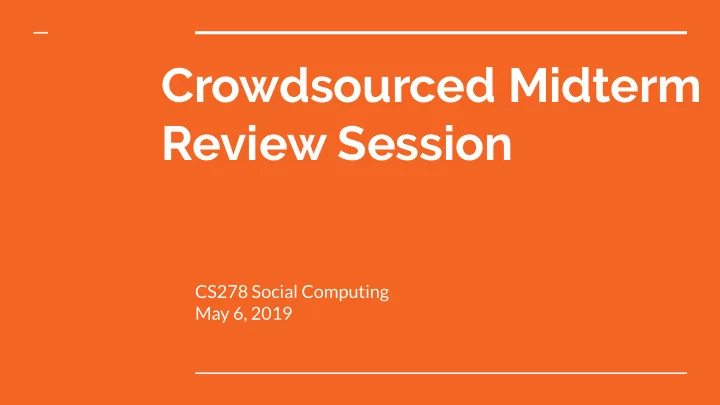

Crowdsourced Midterm Review Session CS278 Social Computing May 6, 2019
Lecture 1: Going Viral What are some sources of cultural ● innovation? What are some instances of social ● proof that you’ve observed or taken part in on social computing systems? How does one make content that ● goes viral?
Lecture 2: Bustling Spaces What is a “sociotechnical system”? ● How do we design for (or around): ● Intrinsic vs. extrinsic ○ motivations? Channel factors? ○ Social loafing vs. reciprocity? ○ User autonomy? ○
Lecture 3: Designing Norms What are some examples of norms ● on sociotechnical systems? How are norms shaped by: ● Defaults? ○ Identity? ○ Cultural context? ○
Lecture 4: gettingstarted.md - prototyping and the cold start problem What makes prototyping for social ● computing systems difficult? Traditional prototyping :( ● Dynamics: sparse vs. dense, weak ● vs. strong. What is the cold start problem? ● What things can we do to mitigate ● this?
Lecture 5: Growing Pains Invisible labor and moderation. ● Information overload and the ● economics of attention. How does the economics of ○ attention relate to growth? Ranking methodologies. ○ Techniques for designing for a ● global community. Building empathy. ●
Lecture 6: Strong and Weak The Strength of Weak Ties ● Granovetter 1973 ○ Strong Ties (thick context): existing ● social networks, social and emotional mental health, multiple vs. single channels - honest signals. Weak Ties (thin context): social ● networks we aren’t in, weak ties = success, single channel. Identity based groups. ● Loneliness. ●
Lecture 7: Group Collaboration Colocated teams are more effective ● than distributed teams. Are there ways distributed teams ○ can be more effective? What is “interdependence”? ● How do we design for ○ interdependent collaboration? What is “Grudin’s paradox”? ● And why does this matter? ○
Lecture 8: Wisdom of the Crowd Crowdsourcing: taking a function once employed by ● employees and outsourcing to an undefined, generally large network in the form of an open call. What is needed for crowdsourcing to be ● effective? Why does crowdsourcing work? ● What are some mechanisms people have used to ● crowdsource? What are some possible problems with ● crowdsourcing?
Midterm: This Wednesday during class time 1:30-2:20pm Come early please to start on time ● Will be on your computer. ● Check out one from Lathrop or ○ see us if there’s an issue. Either Bluebook or Canvas ○ Two different classrooms: ● This room: A-G ○ Room 200-002 H - Z ○
General Midterm Tips Current format: 12 Questions: ● 3+3+3+3 (staff). ○ Different point totals. ○ Go through question bank, make ● sure you understand the meaning of terms (we won’t define them). Think about social systems and ● features: what is different and similar about them?
Recommend
More recommend